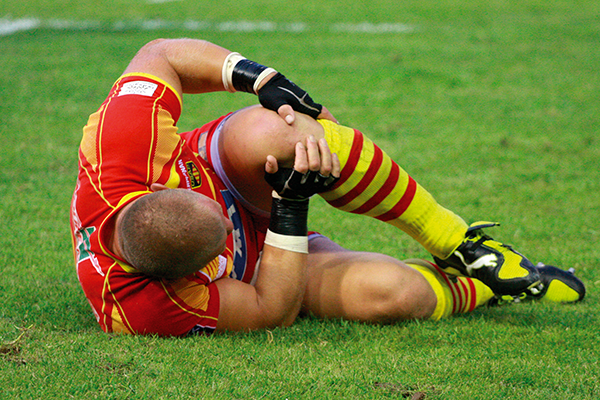Rotational forces and lower leg injury
Revealing the significant results of a SATRA research project.
by David Smith

Image © Santamaradona | Dreamstime.com
The anterior cruciate ligament (ACL) is one of a pair of ligaments within the knee that stabilise and support movements of the knee joint. Tearing of this ligament is one of the most common forms of knee injury, and can occur during sports such as netball, rugby or basketball, or through any number of activities that apply excessive force to the knee, with painful and often long-term consequences.
One factor that can cause such injuries is excessive rotational traction, which can result in high forces being transmitted to these vulnerable anatomic structures. The knee is particularly sensitive to high torque forces – more so than the ankle. Female athletes are several times more likely to tear their ACL than their male counterparts, due to a number of physiological factors. In sports such as basketball and football, sportswomen are nearly three times as likely to suffer an ACL tear than sportsmen, with an overall yearly injury rate of 5 per cent (C.Prodromos et al 2007).
The cause of the problem
A desirable quality for many types of footwear (including sports footwear) is a sole pattern that allows the wearer to twist or pivot a foot relative to the floor without transferring excessive torque (rotational force) to the lower leg, and thereby injuring the ankle or knee. This quality is referred to as 'rotational slip'.
Sudden or unexpected rotational slip is as dangerous as not being able to rotate freely, but the ability to rotate the foot smoothly and under control can help a wearer to avoid many problems.
When we walk or run, we make frequent changes in direction – often subconsciously. During these changes in direction, our feet may temporarily be facing one way and our body heading in another. It is during these moments that we are vulnerable to injury or loss of traction – especially if we are moving at speed, carrying a heavy load or have mobility limitations as a result of disability or old age. Footwear that permits an appropriate degree of rotational slip is, therefore, beneficial – not only for sports footwear, but also for other performance applications, as well as footwear for those with limited mobility or disabilities.
Studies by Torg et al in 1974 and Lambson et al in 1996 concluded that shoe designs with the highest rotational traction yielded correspondingly and significantly higher injury rates than footwear with lower rotational traction. By reducing or controlling the rotational movement of the knee, injuries such as ACL injuries could be minimised, and mobility improved for many wearers otherwise at risk of slips and falls.
An exciting breakthrough

An experimental prototype of the rotating unit
While some degree of rotational slip is required, there is clearly still a need for footwear to exhibit a good level of linear slip resistance, and to have a tread pattern that encourages positive contact between the foot and the floor surface. However, a combination of this linear slip resistance with a tread pattern that permits a degree of rotational slip or some other mechanism for allowing rotation could help to significantly reduce the incidence of lower leg injuries among athletes and other users, and could benefit wearers with mobility issues. Of course, some means of quantifying this ease of rotation is necessary in order to verify the effectiveness of this kind of footwear.
SATRA has conducted considerable research into slip testing over many years, in addition to developing suitable equipment to carry it out. We are currently developing methods of assessing the tendency of footwear to maintain its grip on a test floor as that floor is rotated beneath it.
Using our Pedatron STM 528 test machine and a multi-axis force plate, we are able to dynamically measure torque forces between footwear and flooring during rotation. This testing can be carried out on many different types of footwear, and on a variety of different flooring samples via an interchangeable sample holder.

Components of SATRA’s rotating sole unit
These torque readings allow us to quantify footwear’s rotational slip performance. Future iterations of the test protocol will introduce a controlled rotation until the footwear's static friction is overcome, and then a lateral slide, during which torque and slip resistance will be measured.
SATRA is now in a position to reveal a patented development for a midsole mechanism that can be incorporated into most styles of footwear. This will allow the whole forepart of the shoe to rotate while maintaining excellent traction with the ground. The mechanism can be installed into the midsole of the footwear, with the existing outsole and tread pattern in place as usual.
The unique movement permitted by this mechanism aims to address the twin issues of rotational slip and reduction in potential injurious knee forces. This is achieved by allowing smooth and controlled rotation of the forepart of the footwear (and, thereby, the foot relative to the floor) while buffering the build-up of potentially painful rotational torque forces in the leg.
How can we help?
SATRA is offering the opportunity to licence the use of this mechanism in footwear, and we invite interested members to email research@satra.com for further information.
Publishing Data
This article was originally published on page 20 of the September 2015 issue of SATRA Bulletin.
Other articles from this issue »


 EN
EN ZH
ZH